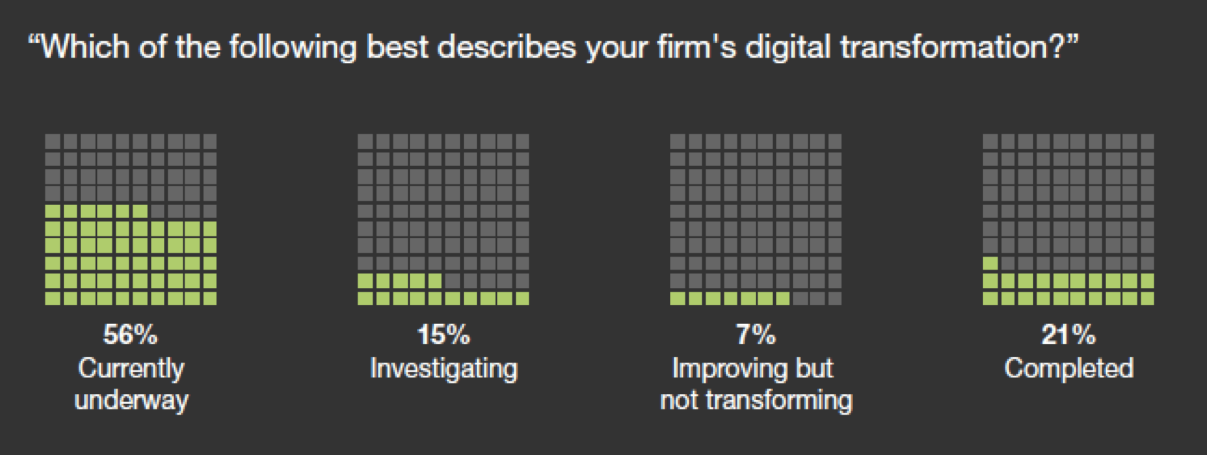Digital transformation has been a red-hot topic of conversation across corporate board rooms and C-suites. Due to the threat of new business models and competitors that are “born digital” and the desire to lower operational costs through technology, large-scale initiatives designed to digitize internal and external practices have become more common in the last ten years. To capture the current state of digital transformation, Forrester surveyed 1,600 business and IT decision-makers in North America and Europe. The results of the study were quite surprising in that 22% of companies are in a holding pattern when it comes to digital transformation and 21% of companies think their transformation is complete.

Additionally, of the 56% of firms that are transforming, their level of investment and scope are still relatively small. So what does this mean? With so many market disruptors and claims about how technology is changing the world, why are we seeing a lack of urgency? Digital transformation is on a spectrum that affects every organization and every industry. At one extreme, the ‘evolve or die’ mentality says that a company will not survive unless it immediately activates broad organizational changes, heavy technology investment, and online channels. Take Blockbuster and Yellow Cab as examples; they didn’t foresee Netflix and Uber coming and failed to digitize in time to survive. No company wants to end up like them. But transformational initiatives need not be so doom-and-gloom. More often than not, our clients’ transformational efforts are focused on modernization, with ROI as a key requirement. They are making digital investments strategically and growing their digital competencies at a pace that doesn’t overwhelm their organization. Regardless of industry or company size, there are four major lessons to learn from our clients who are winning at digital transformation:
1. Position Digital Transformation as a Journey, Not a Project
Too many organizations treat digital transformation as a project with a discrete beginning and a finite end. The Forrester study proves this; 21% of companies think that their transformation is complete. Really? You’re done? Sure, if customer expectations quit rising and technology companies stop innovating, that’s a fair statement to make. But in reality, leading futurists believe we’ll see more change in the next 20 years than we’ve seen in the past 300, with much of that change being fueled by emerging technology. Our clients who win at transformation see it not as a one-time task, but as an ongoing program with a series of new projects year after year. Their approach focuses on incremental change over time rather than a single big bang, and they’re willing to invest significant capital in innovation and exploration of new technologies that raise the bar for customer experiences.
2. Align Your Leadership
Let’s be honest, digital transformation initiatives are expensive and require year-over-year commitment. They require buy-in from every department, executive, manager, and employee. Project failures will happen along the way, so a foundation of organizational resiliency is key. I’ve never seen a transformational effort succeed without comprehensive sponsorship and directive from the entire C-suite. I’ve witnessed first-hand how poor leadership and misalignment can quickly immobilize an organization. I’ve seen smart people make poor decisions because they feared that taking a risk or working differently would mean losing their job. This distrust and lack of alignment could be why 15% of companies are still contemplating starting their digital transformation journey and why 7% are improving, but not transforming.
3. Focus on Fundamentals
With all the hype around Artificial Intelligence, IoT, Mixed Reality, etc. it can be difficult to understand how these emerging technologies can provide measurable ROI for the business. My recommendation to clients is to keep things simple and start with high impact projects with a strong likelihood of success. Digital transformation doesn’t need to be an overwhelming change in product, business model, or paradigm. At its core, transformation is about identifying fundamental parts of your business and cultivating improvement with digital technology; think enhanced rather than changed.
4. Invest in Strategy
What’s the use of running if you’re not on the right road? The foundational investments of digital transformation are extremely important, whether it’s technology platforms, experience models, or operations. A digital strategy will help maximize ROI in these foundational investments, recommend a series of phases and sequencing of projects, and ensure the multiple initiatives along your digital transformation journey is aligned to a higher-level vision and purpose. When things get hard – and they will – a solid strategy will serve as a reminder as to why you’re doing all this in the first place.
First Steps Toward Digital Transformation
As company leaders facing immense technological possibilities, it’s easy to become overwhelmed. What is the right approach, where do you invest, who do you partner with, are you doing enough to remain relevant? The good news is that you are not alone and that every organization has asked the same questions. Start analyzing case studies and learning from companies that are further down the transformation journey. Talk to your peers, reach out to agencies that specialize in digital, open up conversations, and gain different perspectives on what others are doing. From there, you’ll be poised to begin your own journey, and the possibilities for your organization are endless.
—
Ready to get started with digital transformation? Contact us.








